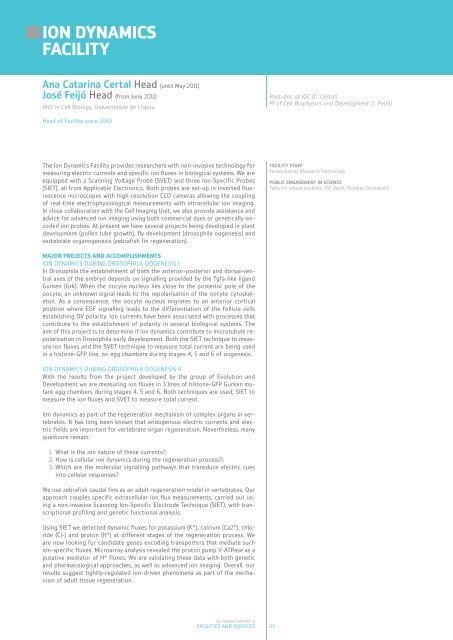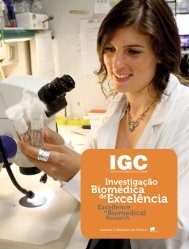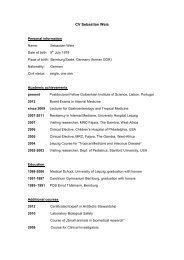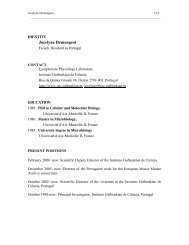organisation - the Instituto Gulbenkian de Ciência
organisation - the Instituto Gulbenkian de Ciência
organisation - the Instituto Gulbenkian de Ciência
- No tags were found...
You also want an ePaper? Increase the reach of your titles
YUMPU automatically turns print PDFs into web optimized ePapers that Google loves.
ION DYNAMICS<br />
FACILITY<br />
Ana Catarina Certal Head (until May 2011)<br />
José Feijó Head (from June 2011)<br />
PhD in Cell Biology, Universida<strong>de</strong> <strong>de</strong> Lisboa<br />
Post-doc at IGC (C. Certal)<br />
PI of Cell Biophysics and Development (J. Feijó)<br />
Head of Facility since 2010<br />
The Ion Dynamics Facility provi<strong>de</strong>s researchers with non-invasive technology for<br />
measuring electric currents and specific ion fluxes in biological systems. We are<br />
equipped with a Scanning Voltage Probe (SVET) and three Ion-Specific Probes<br />
(SIET), all from Applicable Electronics. Both probes are set-up in inverted fluorescence<br />
microscopes with high-resolution CCD cameras allowing <strong>the</strong> coupling<br />
of real-time electrophysiological measurements with intracellular ion imaging.<br />
In close collaboration with <strong>the</strong> Cell Imaging Unit, we also provi<strong>de</strong> assistance and<br />
advice for advanced ion imaging using both commercial dyes or genetically-enco<strong>de</strong>d<br />
ion probes. At present we have several projects being <strong>de</strong>veloped in plant<br />
<strong>de</strong>velopment (pollen tube growth), fly <strong>de</strong>velopment (drosophila oogenesis) and<br />
vertebrate organogenesis (zebrafish fin regeneration).<br />
FACILITY STAFF<br />
Teresa Gomes (Research Technician)<br />
PUBLIC ENGAGEMENT IN SCIENCE<br />
Talks for school stu<strong>de</strong>nts, IGC (April, October, December)<br />
MAJOR PROJECTS AND ACCOMPLISHMENTS<br />
ION DYNAMICS DURING DROSOPHILA OOGENESIS I<br />
In Drosophila <strong>the</strong> establishment of both <strong>the</strong> anterior-posterior and dorsal-ventral<br />
axes of <strong>the</strong> embryo <strong>de</strong>pends on signalling provi<strong>de</strong>d by <strong>the</strong> Tgfa-like ligand<br />
Gurken (Grk). When <strong>the</strong> oocyte nucleus lies close to <strong>the</strong> posterior pole of <strong>the</strong><br />
oocyte, an unknown signal leads to <strong>the</strong> repolarisation of <strong>the</strong> oocyte cytoskeleton.<br />
As a consequence, <strong>the</strong> oocyte nucleus migrates to an anterior cortical<br />
position where EGF signalling leads to <strong>the</strong> differentiation of <strong>the</strong> follicle cells<br />
establishing DV polarity. Ion currents have been associated with processes that<br />
contribute to <strong>the</strong> establishment of polarity in several biological systems. The<br />
aim of this project is to <strong>de</strong>termine if ion dynamics contribute to microtubule repolarisation<br />
in Drosophila early <strong>de</strong>velopment. Both <strong>the</strong> SIET technique to measure<br />
ion fluxes and <strong>the</strong> SVET technique to measure total current are being used<br />
in a histone-GFP line, on egg chambers during stages 4, 5 and 6 of oogenesis.<br />
ION DYNAMICS DURING DROSOPHILA OOGENESIS II<br />
With <strong>the</strong> results from <strong>the</strong> project <strong>de</strong>veloped by <strong>the</strong> group of Evolution and<br />
Development we are measuring ion fluxes in 3 lines of histone-GFP Gurken mutant<br />
egg chambers during stages 4, 5 and 6. Both techniques are used, SIET to<br />
measure <strong>the</strong> ion fluxes and SVET to measure total current.<br />
Ion dynamics as part of <strong>the</strong> regeneration mechanism of complex organs in vertebrates.<br />
It has long been known that endogenous electric currents and electric<br />
fields are important for vertebrate organ regeneration. Never<strong>the</strong>less, many<br />
questions remain:<br />
1. What is <strong>the</strong> ion nature of <strong>the</strong>se currents?;<br />
2. How is cellular ion dynamics during <strong>the</strong> regeneration process?;<br />
3. Which are <strong>the</strong> molecular signalling pathways that transduce electric cues<br />
into cellular responses?<br />
We use zebrafish caudal fins as an adult regeneration mo<strong>de</strong>l in vertebrates. Our<br />
approach couples specific extracellular ion flux measurements, carried out using<br />
a non-invasive Scanning Ion-Specific Electro<strong>de</strong> Technique (SIET), with transcriptional<br />
profiling and genetic functional analysis.<br />
Using SIET we <strong>de</strong>tected dynamic fluxes for potassium (K+), calcium (Ca2+), chlori<strong>de</strong><br />
(Cl-) and proton (H+) at different stages of <strong>the</strong> regeneration process. We<br />
are now looking for candidate genes encoding transporters that mediate such<br />
ion-specific fluxes. Microarray analysis revealed <strong>the</strong> proton pump V-ATPase as a<br />
putative mediator of H+ fluxes. We are validating <strong>the</strong>se data with both genetic<br />
and pharmacological approaches, as well as advanced ion imaging. Overall, our<br />
results suggest tightly-regulated ion-driven phenomena as part of <strong>the</strong> mechanism<br />
of adult tissue regeneration.<br />
IGC ANNUAL REPORT ‘11<br />
FACILITIES AND SERVICES<br />
95






